ISSN ONLINE(2320-9801) PRINT (2320-9798)
ISSN ONLINE(2320-9801) PRINT (2320-9798)
Mukesh P.Mahajan1, Raveena Dua2, Jeshmi Dudhat3, Sachi Patel4
|
| Related article at Pubmed, Scholar Google |
Visit for more related articles at International Journal of Innovative Research in Computer and Communication Engineering
The “tongue drive” system is a tongue operated assistive technology developed for people with severe disability to control their environment. The tongue is considered an excellent appendage in severely disabled people for operating an assistive device. Tongue drive consists of an magnet reed relays outside of the teeth to measure the magnetic field generated by a small permanent magnet secured on the tongue. The sensor signals are transmitted to an encoder which wirelessly transmit signal and processed to display the needs of paralytic person. The tongue is considered an excellent attachment in severely disabled people for operating an assistive device. This paper presents our recent progress to the development of tongue operated smart environment for paralytic people.
Keywords |
| Tongue drive, Reed Relays, parallel to serial data conversion. |
INTRODUCTION |
| The Tongue Drive system (TDS) is a tongue-operated unobtrusive assistive technology, which can potentially provide people with severe disabilities with effective access and environment control. It translates userâÃâ¬ÃŸs intentions in to control commands by detecting and classifying their voluntary tongue motion utilizing a small permanent magnet, secured on the tongue, and an array of magnetic sensors mounted on a headset outside the mouth. The magnetic sensors are nothing but magnetic reed relays. This command of paralytic person will be displayed on screen which will be at far distance from the paralytic person. Thus even if caretaker is not with that paralytic person 24 x 7, his/her needs can be recognized by the Caretakers. It is seen that majority of paralytic people are able to move their tongue. A reed relays will response to changes in magnetic field. When a particular reed relay will be accessed, a particular command (as programmed) will be displayed on display screen. By using this Tongue Drive System, paralytic person will be able to convey him basic needs to his/her caretaker even if the caretaker is not present with the Patients. |
RELATED WORK |
| In [3], the motion of the tongue is traced by an array of magnetic sensors, which measure the magnetic field generated by a small permanent magnet, the size of a grain of rice that is embedded in a biocompatible material such as titanium, and attached to the tongue through piercing, implantation, or adhesion. The magnetic sensors can be either mounted on a dental retainer and clipped on the outside of the teeth (internal TDS or iTDS) or on a headset (external TDS or eTDS) positioned near the cheeks. It is seen that majority of paralytic people are able to move their tongue. Sensor outputs are amplified, multiplexed, digitized, and transmitted wirelessly to an external controller unit. Signals received by the external controller, which can be a portable computer or a Smartphone are processed to indicate the motion of the permanent magnet and consequently the tongue position within the oral cavity. Persons severely disabled as a result of causing ranging from traumatic brain and spinal cord injuries to stroke generally find it extremely difficult to carry out everyday tasks without continuous help. We can assign a certain control function to each particular tongue movement in software and customize the system for each individual user [1]. |
PROPOSED SYSTEM |
| The Tongue Drive System consists of encoder circuit and decoder circuit. Encoder circuit is placed near patient and decoder circuit is placed in room where caretakers/nurses are mostly present. Reed relays (equal to number of smessages) are placed near jaws of the paralysed person and a permanent magnet of size of a grain is placed on patientâÃâ¬ÃŸs tongue.To place the magnet on tongue of the patient, a method called ZIP Surgery can be used or simply an elastic adhesive can be used. |
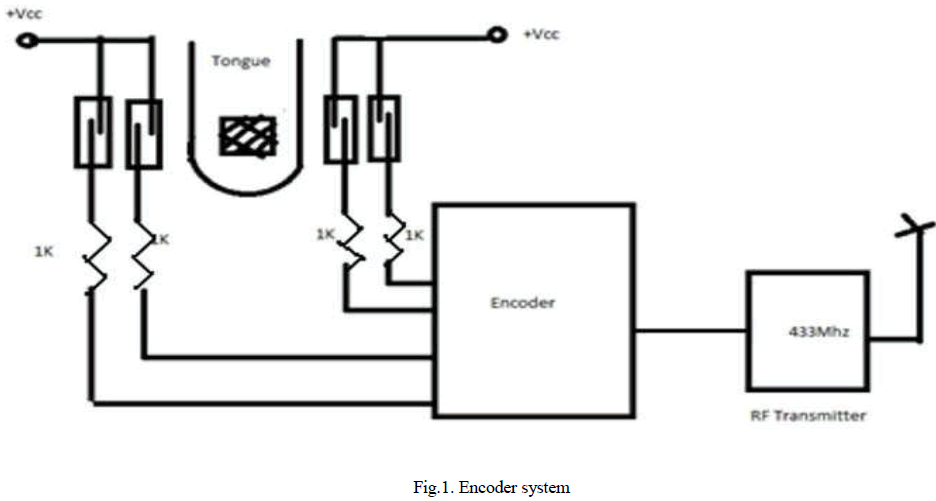 |
| Four reed relays are used (use of number of reed relays is optional). Each reed relays (here4) carry one message as per programmed. Initially Reed relays are inactive. They will get active when patient will move his tongue towards a particular reed relay. Ferromagnetic blades of Reed relay will get connected due to magnet which is placed on tongue and thus signal will be transferred to encoder IC i.e., HT12E. |
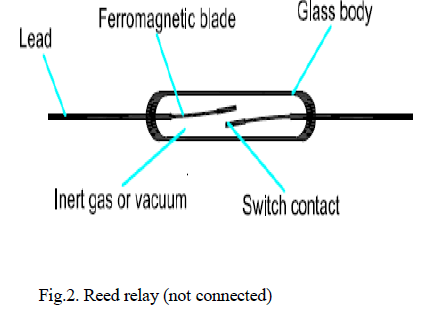 |
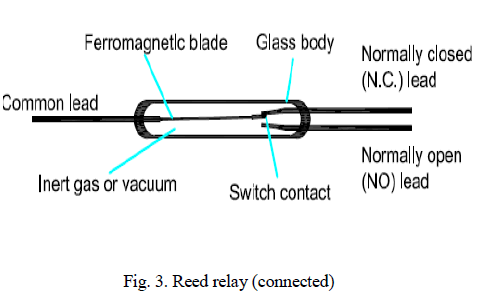 |
| Signal that are received by IC HT12E are parallel data signals. Parallel signals are converted into serial data signal by IC HT12E and then these signals are transmitted by RF transmitter. Encoder IC HT12E is compatible to be used with RF transmitter because RF transmitter only transmits serial data signals. This serial data is a message like Food, Water, emergency, calling alarm, etc. depending on needs of patient the messages are programmed in software. |
| Encoder and decoder HT12E and HT12D are used as encoder and decoder as they are compatible with RF transmitters. Encoder IC HT12E is connecting RF transmitter which uses a frequency of 433 MHz The signal from encoder will be transmitted and received by RF receiver at distance of around 400 meters. |
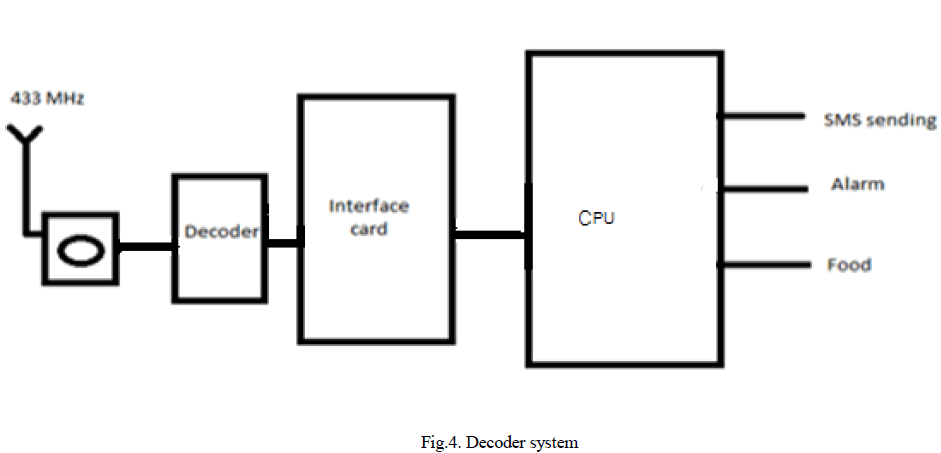 |
| IC HT12D is used as decoder IC. Decoder will decode the signal received by RF receiver. IC HT12D will reconvert the serial data received by RF receiver into parallel data signals. This decoder is interfaced to microprocessor Pentium through interface card. Interface card is connected to CPU thus the signal send by the paralytic person is displayed on screen depending upon which reed relay sensed the magnetic field. Four magnetic reed relays can use for food command, 2ndfor calling alarm, 3rd for water, 4th for emergency. This project is used for paralytic people who are not able to move or communicate with other. It is found that many paralytic people are able to move their tongue. Thus by using this system, they will be able to display their basic needs To their caretakers. This system will have great social impact as this project will reduce the stress of family members of paralytic person as well as it will reduce the time to be spent with such a person. Thus it will not be a compulsion that someone always has to be with such paralytic person. |
IMPLEMENTATION AND RESULTS |
| We have designed the encoder circuit of this system which mainly consists of IC HT12E, an RF transmitter module (433MHz), and 3pin power connector for supply of power. As seen in fig.4. The wires from reed relays are connected to IC HT12E and this IC is connected to RF transmitter module. Depending on the reed relay which is active, the data signal is received by IC HT12E and through RF transmitter module it is transmitted to receiver. |
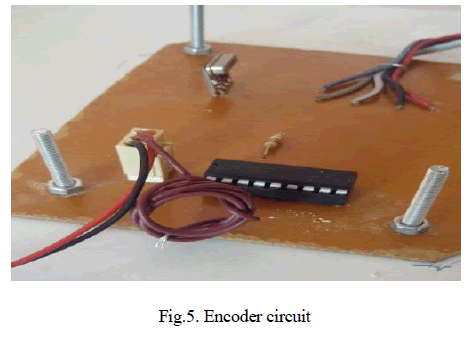 |
| Fig.5. shows the decoder circuit which consist of IC HT12D, RF receiver module (433MHz), LEDS and 3pin power connector. The signal that was sent by RF transmitter will be received by RF receiver. Received signal is then given to IC HT12D. 5 LEDS are used, 1 to indicate that transmission is ON and remaining 4 LEDS are for the indication of one of the four messages given by paralyzed patient. Power limiting resistors are used along with LEDS. The signal received by this circuit is then given to interface card. Interface card will interface this system to Pentium processor (CPU). |
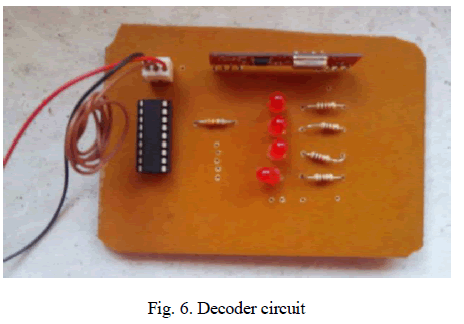 |
| Thus encoder and decoder circuits are designed and tested for its operation of transferring the data signals wirelessly over frequency of 433MHz. |
CONCLUSION AND FUTURE WORK |
| Thus „Tongue operated smart environment for paralytic peopleâÃâ¬ÃŸ which is to be designed will have an social impact on society that deals within ability to communicate or move. The tongue drive system will help paralytic people to convey their needs to their caretaker and they need not to be present 24*7 with patients.A system can be designed where the sensors- embedded in a wireless headset will read the fluctuations in the strength of the magnetic field as the tongue moves and will transmit the signals on to a computer, where they will interpret and acted upon. By moving the tongue in predefined patterns, the user will be able to steer a cursor on a screen, direct a car steering wheel, or switch ON/OFF a lights, fans, TV etc. |
References |
|